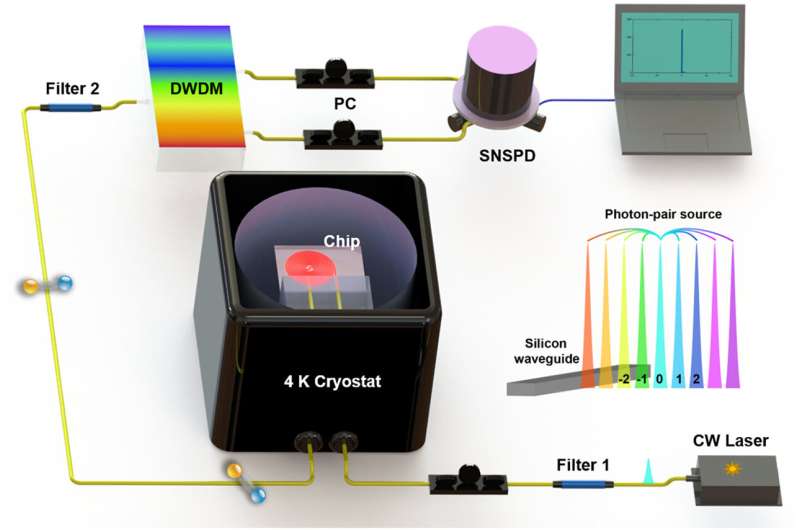This article has been reviewed according to Science X's editorial process and policies. Editors have highlighted the following attributes while ensuring the content's credibility:
fact-checked
peer-reviewed publication
trusted source
proofread
Researchers develop cryogenic integrated quantum entangled light source

The research team led by academician Guo Guangcan and Prof. Ren Xifeng from the University of Science and Technology of China (USTC) of the Chinese Academy of Sciences (CAS) achieved quantum photonic sources at cryogenic temperatures based on the spontaneous four-wave mixing (SFWM) effect. The results are published in Optica.
Quantum photonic integrated circuits (QPICs), with their extremely high phase stability and reconfigurability, are powerful platforms that have fueled a wide range of quantum information applications with significant building blocks and are becoming possible candidates to interface different quantum systems with hybrid integrated techniques.
Current investigations on QPICs mainly focus on operation at ambient temperatures, while many quantum components have to operate under cryogenic conditions. Additionally, quantum technologies must be mutually compatible for the sake of scalable photonic quantum computing and interfacing among different quantum systems. Therefore, QPICs that are designed at room temperature, especially those involving nonlinear processes, should be able to work in cryogenic environments.
The researchers set their eyes on the SFWM effect for its outstanding performance in a variety of nonlinear processes and quantum applications. They managed to make breakthroughs through studying the SFWM effect in an integrated silicon waveguide under cryogenic operation conditions. They revealed that the effect was still in good performance for generating quantum photonic sources.
Then, the researchers investigated the noises from the photon-pair source preparation with cryogenic photon-pairs being generated and experimentally verified with a bandwidth of ~2 THz.
Finally, with the help of a Michelson interferometer, they studied frequency-multiplexed energy-time entangled states.
Researchers from USTC presented an important part of cryogenic nonlinear photonics through the preparation of cryogenic integrated quantum entangled light sources. The results will benefit integrated scalable quantum information applications. Just as the reviewers of Optica stated, this paper provides useful insights into the study of integrated quantum optics in cryogenic environments.
More information: Lan-Tian Feng et al, Entanglement generation using cryogenic integrated four-wave mixing, Optica (2023). DOI: 10.1364/OPTICA.476712
Journal information: Optica
Provided by Chinese Academy of Sciences





















